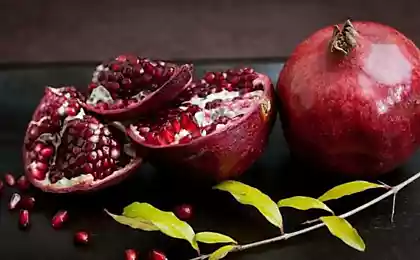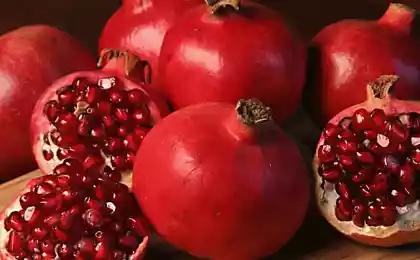457
The amazing healing properties of pomegranate
Fifty four million two hundred ninety two thousand fifteen
©ALBERT HOUTHUESEN
Pounded into powder, pomegranate seeds, mixed with honey in the ratio 1:4 as ointments are a good remedy for negroide and malignant ulcers. The petioles of pomegranate, especially baked, are used for healing wounds. Warm colors of the wild granatniy helps considered wounds. For the swelling in the ear, cook in wine, sweet pomegranate, pound it and apply as a compress on the ear.
A decoction of the bark grenades in folk medicine, sometimes used for helminthiasis. However, it is less effective in comparison with the male fern. Treatment of helminthiasis pomegranate: grind 40-50 grams of bark pour 400 ml of water, infuse for 6 hours, boil until then, until the liquid is evaporated to 200 ml. After straining to cool. Before treatment pomegranate bark conduct regular training of the patient. Then he is given to drink a decoction of 200 ml within 1 h. after half an hour, prescribed a laxative. Due to the relatively low activity preparations of the bark of pomegranate are advised to apply only in those cases when the male fern is contraindicated.
When receiving broth may appear toxic symptoms: dizziness, weakness, cramps, impaired vision. To prevent toxic effects of the decoction of the bark of granatniki appoint together with astringent substances, for example tannin. In this case, the drug is little absorbed and has no toxic effect.
The use of pomegranate in folk medicine. The history of herbs brought us interesting information about the grenade. From Greek mythology we learn that Proserpine Pluto has not left only because he begged her to share with him in half pomegranate. This led to the belief that garnet is always necessary to share with a loved one. Astrologers believe that where powerless medicine, pomegranate juice will help those born under the sign of Aries. Hippocrates prescribed pomegranate juice for pain in the stomach, peel the fruit for dysentery and for wound healing. The doctors of Ancient Rome, India, Armenia decoction of roots and bark expelled tapeworms. The Arabs used the pomegranate in the gastro-intestinal disorders and headaches.
Medicinal properties of pomegranate juice. The juice is usually consumed as the vitamins in fresh and canned form. It also stimulates the appetite, regulates the activity of the gastrointestinal tract, is a strong astringent and analgesic effect. Flowers of pomegranate have astringent and antiseptic properties, leathery pericarp and astringent and hardening effect. The bark of roots and branches paralyzes tapeworms. Fatty oil of seeds is characterized by hormonal activity.
Medicinal properties of pomegranate jumpers. White jumper between the grains were dried and added to tea for nervous agitation, anxiety, insomnia.
For medicinal purposes, and still use tree bark and roots, flowers, fruit peel, juice from the beans.
Graft contraindications. Given the serious contraindications self undesirable conduct. In the treatment of garnet should not forget that the fruits are contraindicated in patients with chronic constipation, with fissures in the rectum and hemorrhoids. Constipation caused by garnet, in vain attempts and emptied often causes bleeding. If you exceed the dosage can provoke gastrointestinal bleeding, and drugs from the bark of pomegranate. In the bark contains alkaloids that can cause total blindness. The use of decoction of bark and roots to expel tapeworms and bone fractures, is contraindicated in hypertension, as it greatly increases the pressure. Even a person with normal or low blood pressure broths such an overdose can cause dizziness, weakness, vomiting, seizures, impaired vision. Pomegranate is contraindicated in hepatitis and acute nephritis. Pomegranate juice is not desirable to combine with other medications, especially antihistamines.published
P. S. And remember, only by changing their consumption — together we change the world! ©
©ALBERT HOUTHUESEN
Pounded into powder, pomegranate seeds, mixed with honey in the ratio 1:4 as ointments are a good remedy for negroide and malignant ulcers. The petioles of pomegranate, especially baked, are used for healing wounds. Warm colors of the wild granatniy helps considered wounds. For the swelling in the ear, cook in wine, sweet pomegranate, pound it and apply as a compress on the ear.
A decoction of the bark grenades in folk medicine, sometimes used for helminthiasis. However, it is less effective in comparison with the male fern. Treatment of helminthiasis pomegranate: grind 40-50 grams of bark pour 400 ml of water, infuse for 6 hours, boil until then, until the liquid is evaporated to 200 ml. After straining to cool. Before treatment pomegranate bark conduct regular training of the patient. Then he is given to drink a decoction of 200 ml within 1 h. after half an hour, prescribed a laxative. Due to the relatively low activity preparations of the bark of pomegranate are advised to apply only in those cases when the male fern is contraindicated.
When receiving broth may appear toxic symptoms: dizziness, weakness, cramps, impaired vision. To prevent toxic effects of the decoction of the bark of granatniki appoint together with astringent substances, for example tannin. In this case, the drug is little absorbed and has no toxic effect.
The use of pomegranate in folk medicine. The history of herbs brought us interesting information about the grenade. From Greek mythology we learn that Proserpine Pluto has not left only because he begged her to share with him in half pomegranate. This led to the belief that garnet is always necessary to share with a loved one. Astrologers believe that where powerless medicine, pomegranate juice will help those born under the sign of Aries. Hippocrates prescribed pomegranate juice for pain in the stomach, peel the fruit for dysentery and for wound healing. The doctors of Ancient Rome, India, Armenia decoction of roots and bark expelled tapeworms. The Arabs used the pomegranate in the gastro-intestinal disorders and headaches.
Medicinal properties of pomegranate juice. The juice is usually consumed as the vitamins in fresh and canned form. It also stimulates the appetite, regulates the activity of the gastrointestinal tract, is a strong astringent and analgesic effect. Flowers of pomegranate have astringent and antiseptic properties, leathery pericarp and astringent and hardening effect. The bark of roots and branches paralyzes tapeworms. Fatty oil of seeds is characterized by hormonal activity.
Medicinal properties of pomegranate jumpers. White jumper between the grains were dried and added to tea for nervous agitation, anxiety, insomnia.
For medicinal purposes, and still use tree bark and roots, flowers, fruit peel, juice from the beans.
Graft contraindications. Given the serious contraindications self undesirable conduct. In the treatment of garnet should not forget that the fruits are contraindicated in patients with chronic constipation, with fissures in the rectum and hemorrhoids. Constipation caused by garnet, in vain attempts and emptied often causes bleeding. If you exceed the dosage can provoke gastrointestinal bleeding, and drugs from the bark of pomegranate. In the bark contains alkaloids that can cause total blindness. The use of decoction of bark and roots to expel tapeworms and bone fractures, is contraindicated in hypertension, as it greatly increases the pressure. Even a person with normal or low blood pressure broths such an overdose can cause dizziness, weakness, vomiting, seizures, impaired vision. Pomegranate is contraindicated in hepatitis and acute nephritis. Pomegranate juice is not desirable to combine with other medications, especially antihistamines.published
P. S. And remember, only by changing their consumption — together we change the world! ©






















